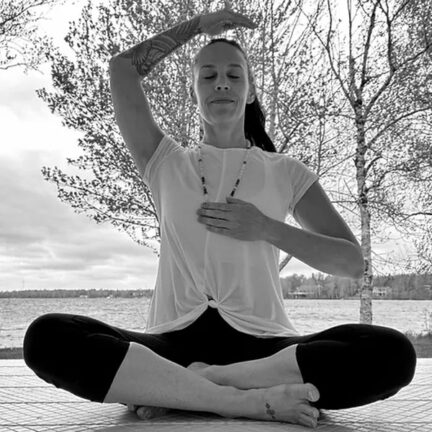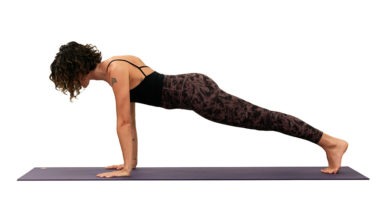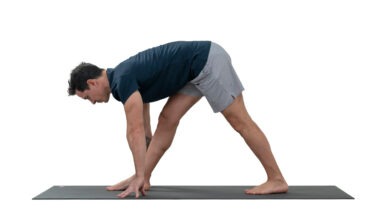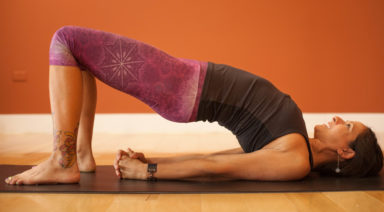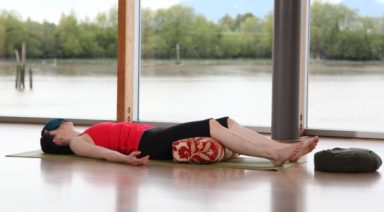5 Yoga Poses to Boost Your OM-munity

Have you ever noticed that a day after you start your vacation you get sick? Or perhaps a sniffle or cough comes on right before your important work presentation? Or maybe you get taken out by a sore throat or ear ache when you have the most on your plate?
Sadly, bacteria and viruses don’t work around our schedule and can take up residence in your body whether you invite them in or not. The immune system has important job to do each and every day, and if we are sleep deprived, eating on the run, overwhelmed and stressed out, and not taking good care of our body, mind, and emotions, it has a profound effect on its ability to ward off dis-ease.
The health of a women’s immune system depends on the health of all our systems. For almost every health condition a woman faces, we can often trace it back to hormonal imbalances. Colds and flu included, since one of our many systems responsible for a strong immune system is the endocrine system, which includes your ovaries, pituitary, adrenals, thyroid, and hypothalamus. All these organs/ glands are also directly responsible for your monthly menstrual (moon) cycle and regulating hormones.
The nervous, digestive, and circulatory systems also work along with your endocrine system to boost your immune system’s response to invaders. However, if we are experiencing stress and overwhelm, for example, these system functions are jeopardized. This in turn influences your hormones causing you to become susceptible to sickness.
In addition, your emotional state affects your physical health so if you are feeling healthy and vibrant, mostly likely your immune system does too and the team of trillions on white blood cells will attack unwelcome invaders with no fear. Except that throughout a woman’s monthly cycle our emotions can be a roller coaster ride ultimately impacting our ability to stay healthy and virus free.
Our yoga asana practice is a refuge where we can go and take time to nourish and replenish all our systems so that they can function optimally. Yoga asana can help improve our circulation, support our central nervous system, clear the mind, balance emotions, and uplift the spirit. Each of these individual benefits will, collectively, assist in harmonizing the endocrine system and stabilize hormones.
In addition, we want to be sure that we get adequate sleep, 8-9 hours a night, eat foods high in vitamin C and A which stimulate our immunity, and surround ourselves with joy and laughter. Laughter also helps fuel and boost immunity and encourages a positive outlook which helps too!
1. Downward Dog (Adho Mukha Svanasana)
Helps to increase upper body circulation, bring fresh blood to the brain, energizes the legs, and is soothing and calming for intense emotions especially when done with a block or bolster under the head. Calm and rejuvenate!
2. Bow Pose (Dhanurasana)
Puts pressure on the belly which increase blood flow to the abdominal organs which is full of the white blood cells that help us fight invaders. Bow also activates the thymus in the chest that is the primary immune system organ. Invigorate and enliven!
3. Child’s pose (Balasana)
Is calming for the central nervous system and allows the adrenals to relax by receiving the ‘sign’ that there is no distress from your long, deep breaths. Then the immune and digestive systems can return to a balanced state and circulate freely to look for those pesky ‘invaders’. This pose can also be great right before bed to assist in a better nights sleep. Restore and relax!
4. Simple Seated Twist (Bharadvajasana)
Stimulates the spleen, kidneys, liver, and circulation to the belly and reproductive organs which produce immune cells. It also stimulates the flow of lymph fluid through the nodes in groin and the armpits. Replenish and renew!
5. Shoulderstand (Sarvangasana)
Helps bring oxygenated blood to your thyroid and parathyroid glands, supports the lymphatic system in passive circulation, calms the mind and emotions, and soothes nerves if you feel stressed or overwhelmed. Moving in to Plow pose will also help to balance your entire endocrine system which in turn will balance your hormones and emotions.
I also suggest practicing according to your monthly cycle and changing what you practice when in accordance to where you are in your personal cycle. This will make these asanas even more potent and powerful keeping you healthy and balanced all year long. Read my article, Manage Your Mood: Balance Your Cycle With Your Practice to learn how to practice according to your monthly cycle.
Partner Yoga Poses: The Power of Connectivity
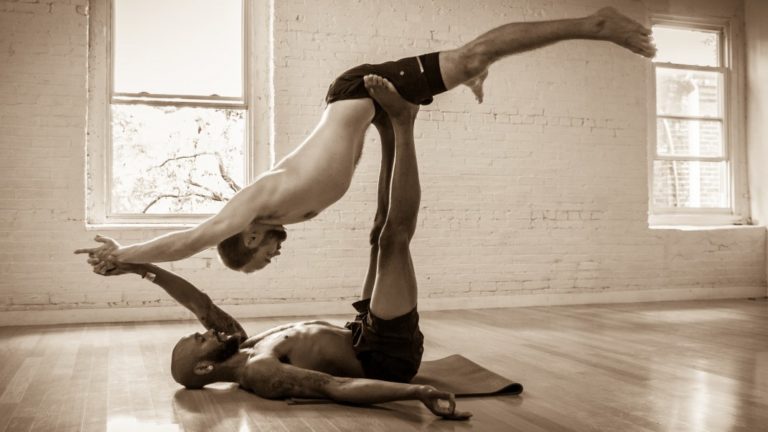
Want to heighten your yoga experience? Deepen your practice through body and mind with partner yoga: Partner Yoga Level One and Partner Yoga Level Two, led by instructor Pedro Franco, are perfect for yoga lovers. Partner yoga is a practice for any level of yogi. It can be done with a friend, loved one or acquaintance. Through this fun and connected series, you will learn to strengthen and amplify your practice by creating a greater sense of awareness in your own body while also paying close attention to the presence and movements of your partner. Partner yoga poses are great if you want to try something new or to spice things up in your relationship with more intimate couples yoga poses.
Things to Keep in Mind When You Start Your Partner Practice
- Partner yoga does not have to be complicated to be beneficial
- Partner yoga can simply be sitting back-to-back with your partner and breathing. It can be meditative. It can be as simple as massaging your partner’s sacrum after a stretch or wiggling your partner’s legs after a flying pose
- Partner yoga works on the same principles as individual yoga: Listen to your body and do what feels right. Challenge yourself, but only to a healthy limit
- If you’re new to partner yoga, take time to build strength, stability and flexibility in order to grow in the practice. Remember that in any form of yoga, there is no competition. For as many times as you stumble, you have just as many opportunities to try again. It is the act of connecting that matters most, not reaching a pose
Start with a Simple Partner Yoga Pose
Partner yoga can be a challenge for even the most advanced practitioner: It doesn’t matter how many hours you have spent on your mat, how many downward dogs or side crows you have done in your life. Maybe you are focused and resilient but need to work on your strength. Maybe you are strong and advanced in your movements but need to work on the act of giving yourself to your partner in a selfless manner.
Partner Seated Spinal Twist (Janu Sirsasana)
-
Begin by sitting back-to back in a comfortable cross-legged seated position
-
Each partner places their right hand on the other’s partner’s left thigh just above knee
-
Put your left hand on your own right knee
-
Coordinate your breathing by lengthening through spine on each inhale
-
During each exhale, twist a little more
-
Come back to center seated and repeat on other side
Learn the Art of Balancing with Your Partner
Partner yoga is not just about you. It is about the other person, too. Partner yoga poses exist to teach yogis and anyone interested in the practice how to gain better awareness and alignment of the body through precise adjustments and articulated movements.
Partner Boat Pose (Navasana)

-
Start by having each partner sit at the end of the mat facing each other
-
Each partner will bend their knees and press the soles of their feet together
-
Connect by clasping each other’s hands
-
While keeping the soles of your feet together, lean back slowly
-
Lengthen your legs and reach your feet upward to a bent-legged boat pose
-
Continue to breathe while you work on your balance
Create Greater Intimacy with Your Partner
Partner yoga can be as intimate as you allow it to be. Partner yoga is for anyone and everyone. It is about trust. It is about connection. It is about feeling the electric sensation between you and another person. It has the power to strengthen bonds between friends, unite strangers and fuse couples together in a new and stimulating way. Partner yoga has the powerful ability to create a profound level of intimacy between two people. The combination of breath, balance, trust and connection create for a unity that is unlike any other. It is assumed by many that partner yoga is purely sexual. This is not true. Yes, partner yoga can be a sensual experience if you want it to be, especially in couples yoga poses. It can also be an experience of unity in a completely different way. It can be whatever you want it to be. That is the beauty of the practice.
Partner Dancer’s Pose (Nataranjasana)

-
Start by standing up toward the back edge of your mat, facing your partner
-
Grab your partner’s right hand
-
Each partner will slightly bend the knees
-
Shift your weight onto your right leg
-
Bend the left knee and gran onto the inside of the left ankle or calf with your left hand
-
Gently pressing your shin into your left hand, open your back
-
Finally, reach your right arm up to balance
-
Repeat on the other side
Connect with Your Partner
Partner yoga is not just about you. Partner yoga has the word partner in it for a reason. It is a practice for two and is a practice that focuses on the unity of two. This is the idea that we should be incorporating in our partner yoga practice. Listen to your partner’s needs. Are they comfortable? Do they feel supported? Do they feel capable of holding you in a pose? Are they calm and present? Through the power of breath and touch, you will be able to sense your partner’s physical and emotional state. Yes, you need a partner to fly. You need a partner to pull your legs and lift you up. But your partner also needs you. It all comes back to unity. In these partner yoga poses and couples yoga poses, we rely on each other and so we must move in a way that represents that.
Double Standing Forward Bend (Uttanasana)
-
Stand back-to-back with your partner
-
Leave about 6 to 12 inches between you and your partner’s heels
-
Each partner will bend at the waist and come to a forward fold
-
Reach your hands behind you
-
Grab onto your partner’s hands
-
As you increase flexibility, you may be able to grab your partner’s forearms, elbows or even shoulders
-
Walk your heels closer until your bottoms are touching and straighten your legs
-
Lengthen the spine, head dangling toward the ground
Explore AcroYoga
AcroYoga is the combination of yoga, massage and acrobatics. As with partner yoga, which often includes acrobatic poses, shown in the Partner Yoga Level Two video, it is important to focus on the building blocks of your practice. Start with what you know and allow yourself to grow through continual practice, one step at a time. Motivation and repetition are the keys to helping you excel at AcroYoga. A common misconception about AcroYoga is that the size of your partner matters. This is not always true. Believe it or not, you have the ability to lift someone twice your weight. It is all about your technique.
As an extension of partner yoga, AcroYoga relies on the same principles: trust, communication and connection. Once you master these skills, you will be flying in the air and lifting people up with your feet in no time. Here is a fun beginner’s partner AcroYoga pose to test out your skills.
Flying Plank (A)
-
Base lies on back
-
Base places legs up in the air, heels over hips
-
Flyer starts by standing facing the base, with their toes almost touching the base’s glutes
-
Base bents knees slightly to bring feet to the hipbones of the flyer
-
Base and flyer connect hands, palm to palm and fingers interlaced
-
Flyer leans forward into the base’s feet
-
With flyer’s body in a single line, the base will receive the weight of the flyer in their feet
-
Base will then straighten their legs and stack their heels directly over the flyer’s hips
-
The flyer should have an engaged core, and the base should have straight arms and shoulder blades firmly grounded into the mat for maximum support and balance
From Flying Plank, yogis can work into the variation below: the flyer leans into the base’s hands instead of feet.

Flying plank photo credit: Amy Goalen
Just as we protect our family, friends and loved ones, we must protect each other when practicing partner yoga. Emotionally and physically, we must rely on each other to reach the ultimate goal of unity and connection.
Thank you to Amy Goalen for providing the beautiful main article image!

